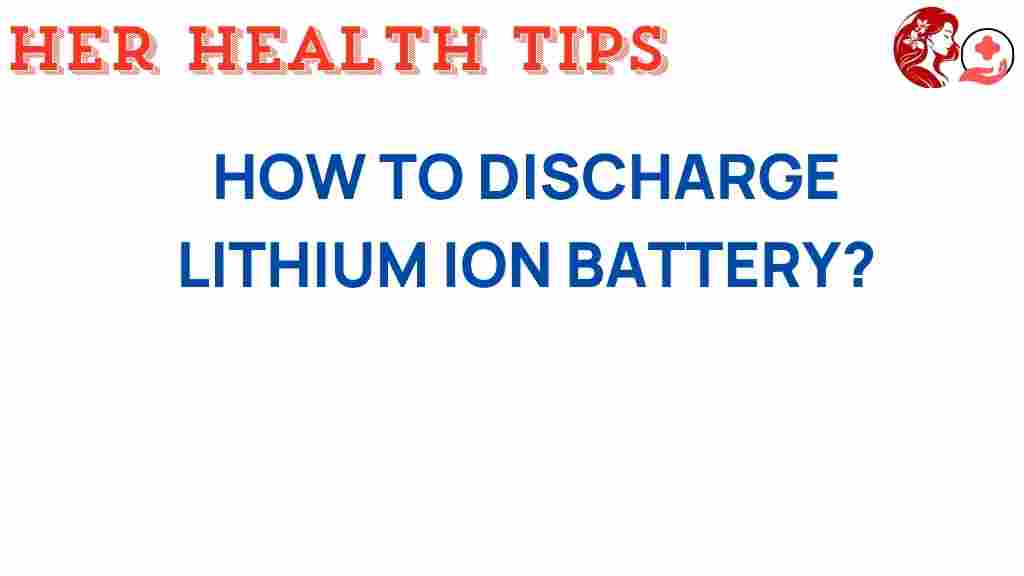Unraveling the Secrets of Lithium-Ion Battery Discharge
In the modern world, the dependency on technology has driven the demand for efficient energy storage solutions. At the forefront of this revolution is the lithium-ion battery, a key player in various applications, notably in electric vehicles (EVs), portable electronics, and renewable energy systems. Understanding the intricacies of battery discharge is essential for maximizing performance, enhancing safety, ensuring sustainability, and paving the way for future innovations.
What is a Lithium-Ion Battery?
A lithium-ion battery is a type of rechargeable battery that has become synonymous with modern energy storage solutions. These batteries utilize lithium ions, which move from the anode to the cathode during discharge and back when charging. Their popularity stems from their high energy density, lightweight nature, and low self-discharge rates.
The Importance of Battery Discharge
The process of battery discharge refers to the release of stored energy in a battery when it is connected to a load. Understanding this process is crucial for several reasons:
- Efficiency: Knowing how to manage discharge rates can enhance the overall efficiency of devices.
- Safety: Improper discharge can lead to overheating or even thermal runaway.
- Sustainability: Efficient discharge management contributes to longer battery life, reducing waste.
The Science Behind Lithium-Ion Battery Discharge
The discharge process of a lithium-ion battery involves chemical reactions that occur within the battery cells. These reactions release electrical energy, which powers electronic devices. Here’s a step-by-step breakdown of this complex process:
Step-by-Step Process of Lithium-Ion Battery Discharge
- Initial State: The battery is fully charged, with lithium ions concentrated at the anode.
- Connection to Load: When the battery is connected to a device, a circuit is completed, allowing the current to flow.
- Ion Movement: Lithium ions begin to move from the anode to the cathode through the electrolyte solution.
- Energy Release: As ions move, they release energy, which is harnessed by the connected device.
- End of Discharge: The battery continues to discharge until it reaches a specified cutoff voltage, indicating it needs recharging.
Factors Affecting Battery Discharge
Several factors can influence the discharge characteristics of a lithium-ion battery:
- Temperature: Extreme temperatures can affect performance and safety.
- Charge Cycle: The number of charge and discharge cycles impacts battery longevity.
- Discharge Rate: High discharge rates can lead to faster degradation of the battery.
Understanding Efficiency and Safety in Lithium-Ion Batteries
While lithium-ion batteries are known for their efficiency, it is essential to understand how to maintain it. Efficiency directly correlates with how well a battery can release energy during battery discharge.
Efficiency Tips
- Avoid Deep Discharging: Frequent deep discharges can reduce battery life significantly.
- Optimal Charging: Use smart chargers that prevent overcharging.
- Regular Inspections: Check for any signs of wear and tear to ensure optimal performance.
Safety Considerations
Safety is paramount when dealing with lithium-ion batteries. Here are some key points to consider:
- Monitor Temperature: Keep batteries within recommended temperature ranges.
- Avoid Physical Damage: Damaged batteries can pose serious risks.
- Use Quality Components: Ensure that chargers and devices are compatible and of high quality.
Recycling Lithium-Ion Batteries: A Sustainable Approach
As the demand for energy storage grows, so does the need for sustainable practices. Recycling lithium-ion batteries plays a crucial role in this regard.
Benefits of Recycling
- Resource Recovery: Valuable materials such as lithium, cobalt, and nickel can be recovered and reused.
- Environmental Protection: Proper recycling reduces the risk of hazardous waste.
- Energy Savings: Recycling typically requires less energy compared to producing new batteries from raw materials.
How to Recycle Lithium-Ion Batteries
Recycling lithium-ion batteries is crucial for sustainability. Here are steps to recycle them properly:
- Locate a Recycling Center: Find a local facility or retailer that accepts lithium-ion batteries.
- Prepare the Batteries: Ensure they are not damaged and place them in a plastic bag.
- Drop Off: Take them to the designated recycling location.
For more detailed guidelines, check out this EPA recycling resource.
Innovation in Lithium-Ion Technology
Innovation continues to drive advancements in lithium-ion technology. Researchers are exploring new materials and methods to enhance battery performance.
Emerging Technologies
- Solid-State Batteries: These batteries promise to deliver higher energy densities and improved safety.
- Graphene Batteries: Potentially offering faster charging times and longer lifespans.
- Recyclable Battery Designs: Innovations aimed at making batteries easier to recycle.
Troubleshooting Common Lithium-Ion Battery Issues
Even the best technology can encounter issues. Here are some common problems and their solutions:
Common Issues
- Poor Battery Life: Ensure the device is not constantly exposed to extreme temperatures.
- Overheating: Check for defective chargers or use of non-compatible devices.
- Slow Charging: Inspect charging cables and ports for damage or dirt.
Solutions
Follow these guidelines to troubleshoot your lithium-ion battery:
- Perform a Battery Calibration: Allow the battery to discharge completely before recharging it fully.
- Replace Old Batteries: If your battery is significantly older or used, it may be time for a replacement.
- Consult Professionals: If issues persist, seek help from a qualified technician.
Conclusion
Understanding the secrets of lithium-ion battery discharge is essential for maximizing the efficiency, safety, and sustainability of this technology. As we embrace the future of energy storage, particularly in electric vehicles and renewable energy systems, it becomes imperative to manage battery discharge effectively. With ongoing innovations and a focus on recycling, the future of lithium-ion technology looks promising. By adhering to best practices and staying informed, we can ensure that our reliance on these batteries contributes positively to our environment and technological advancement.
For further insights into energy storage and sustainability, visit our resource page.
This article is in the category Conditions and created by HerHealthTips Team
